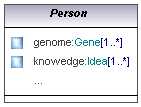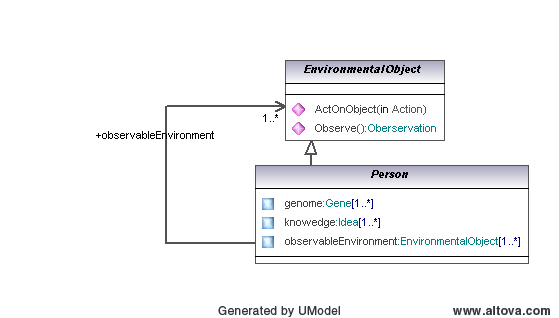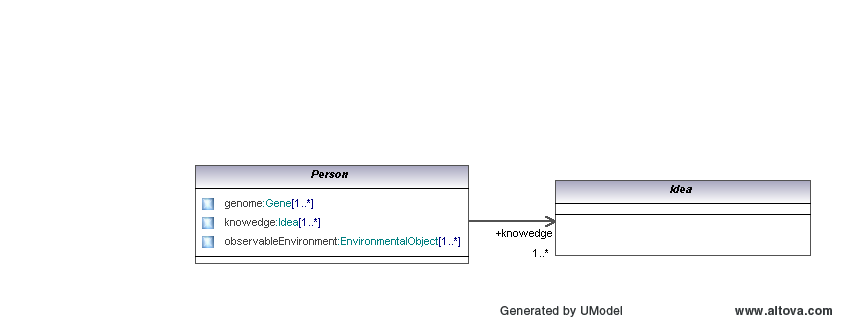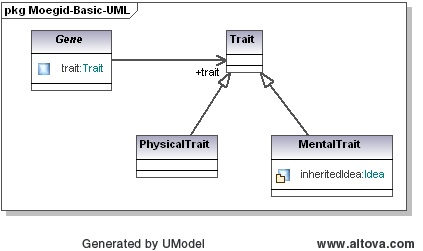MOEGID Basic Model
Overview
The MOEGID basic model describes how people have two essential attributes through which they evolve: genes and ideas. People exist within an environment with which they interact through observation. Ideas can be acquired through interacting with the environment: firstly through action on, and observation of, the environment, and secondly through a specific form of action & observation with other peolple - communication. In addition, ideas can be acquired through gentic inheritance providing the basic traits of a person.
Elements of the basic model are:
Person
The key element of MOEGID is the Person class as shown in the following figure:

This has two attributes:
- genome: The set of genes (genetically acquired traits) which that person has inherited.
- knowledge: The set of ideas which that person has learnt through interacting with his/her environment.
Environment
The person is next extended to model how the Person interacts with the environment as shown in the following figure:

An additional attribute observableEnvironment is added to Person. The observableEnvironment attribute consists of a set of EnvironmentalObjects with the person interacts (observes, acts).
An EnvironmentalObject is used to describe all objects in the world in which a Person exists. This can include animals, land, food, tools etc, as well as persons. Two basic operations can be carried out on an EnvironmentalObject:
- observe: where the observable state of an object can be obtained.
- actOnObject: where a given action is carried out by the person on that object changing its state.
Observation is used in its broadest sense to cover any form of sensory perception: touching, smelling, hearing etc, even observing thought processes.
UML provides two forms of notation that is used to describe the relationship between an
EnvironmentalObject and a Person. Firstly the subclass arrowed line
indicates that an example (sub-class) of
EnvironmentalObject is a Person. Secondly, the association arrowed line
indicates that a Person
has an attribute (observableEnvironment) that describes the set of EnvironmentalObjects
(including itself and other persons) with which it can interact.
Note that each Person has its own view of the EnvironmentalObjects which it can observe and act on.
Idea
An idea is the basic element of mental impression of a person or other being. Together the set of of ideas (knowledge) of a person controls the mental process which results in an action given given a set of observations of the observable environment. In this model an idea is used to present information acquired by a being both through interaction with its/his/her environment as well as genetically acquired information.
Ideas can be associated (e.g. lions is linked to fear, and fear is linked to running away, running away is linked to a set of thoughts which controls movement called running).
The basic model does not identify any specific attributes of an idea or operations that can be carried out on an idea. Further refinements of this model (e.g. Ideas, emotion and action) suggest some refinements of the basic model adding attributes and operations.
The set of ideas (knowledge) of a person controls the actions carried out on its environment given a set of observations made on the person's environment (observableEnvironment).
An idea is an sub-class of environmental object which a person can observe and act upon.
An idea is acquired either through genetic inheritance (see Genes and Genetic Inheritance
or interaction with the environment (see communication and evolution of ideas).

Examples of ideas are:
- Self
- Fear(Observations)
- Tool(Design, Object)
- Tactic (Observations, Actions)
- Ownership (EnvironmentalObect)
- God
Genes and Genetic Inheritance
The set of genes (genome) of a person encode the physical and mental traits inherited from a father and mother.
In this model the the genetic model is simplified to their being a direct relationship between a Gene and the physical or mental trait derived from this Gene. Whilst genetic research indicates there is no such direct relationship it is not thought that this simplification has direct impact on the ability of of MOEGID to help in understanding the evolution of ideas.
The two sub-classes of Gene are represented by the following class diagram:

[To be added representation of Father and Mother and genetic inheritance in UML.]
Assumptions
- Observation - is used to cover any sensory perception: whether visual, touch, hearing or even remote sensing using a tool such as a TV camera.
- A person can only interact with his/her observable environment.
- An idea includes information acquired by a being both through interaction with the environment as well as genetically acquired information.
- Gene - In this model the the genetic model is simplified to their being a direct relationship between a Gene and the physical or mental trait derived from this Gene. Whilst genetic research indicates there is no such direct relationship it is not thought that this simplification has direct impact on the ability of of MOEGID to help in understanding the evolution of ideas.